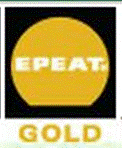| Standards and Certification | |||||||||||
Standards play a central role in modern information technology. Standards that address issues relating to green practices or sustainability are relatively recent. A number of standards are in place or under development to help guide your green decision making.
EPA Energy Star EPA Energy StarThe Environmental Protection Agency (EPA) created Energy Star — a voluntary energy-efficiency certification program of the United States government run jointly by the EPA and the Department of Energy. The program covers a wide variety of electrical devices including home appliances, heating and cooling systems, lighting, and office equipment. The last category covered under this certification includes desktop and laptop computers, monitors, printers, and power adapters.
The EPA intends to extend the specification to network and storage equipment and integrate workload metrics into the specification. EPEATThe Electronic Product Environmental Assessment Tool (EPEAT) is a program developed by the Green Electronics Council that lets manufacturers of electronic equipment report how their products measure up against a set of 51 criteria. These criteria are contained in the IEEE 1680 and IEEE 1680.1 specifications ; 23 of them are required and the other 28 are optional.
EPEAT consider the following categories:
RoHSThe European Union's Regulation of Hazardous Substances (RoHS) directive aims to restrict certain dangerous substances commonly used in electronic and electronic equipment. Any RoHS compliant component is tested for the presence of Lead (Pb), Cadmium (Cd), Mercury (Hg), Hexavalent chromium (Hex-Cr), Polybrominated biphenyls (PBB), and Polybrominated diphenyl ethers (PBDE). For Cadmium and Hexavalent chromium, there must be less than 0.01% of the substance by weight at raw homogeneous materials level. For Lead, PBB, and PBDE, there must be no more than 0.1% of the material, when calculated by weight at raw homogeneous materials. Any RoHS compliant component must have 100 ppm or less of mercury and the mercury must not have been intentionally added to the component. WEEEThe Waste Electrical and Electronic Equipment (WEEE) directive is the European Community directive 2002/96/EC, which details how electronic waste (e-waste) is to be handled. It places responsibility for the safe disposal and recycling of such waste with the original producer of the equipment, requiring them to take back discarded machines from the end user. SpecPowerThe Standard Performance Evaluation Corporation (SPEC) is a series of software benchmarks for evaluating computer system performance. SPEC has added a SpecPower benchmark to evaluate power versus performance characteristics of server-class computers. The first version of their energy benchmark, SpecPower SSJ2008, measures server-side Java performance, by testing the server-side performance of CPUs, caches, memory hierarchy, and shared memory processors. |
|||||||||||
| Copyright © National Computer Board |
| This site is best viewed in 1024 x 768 resolution. Internet Explorer 6.0 + |






